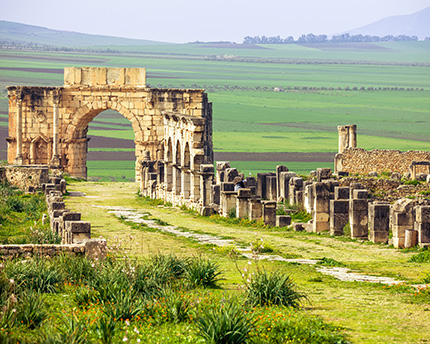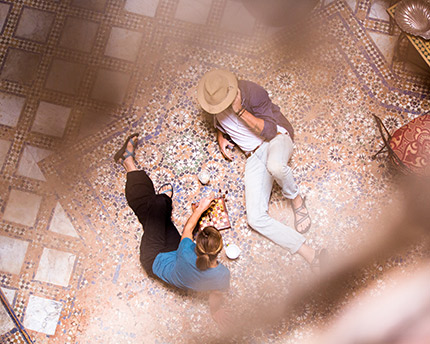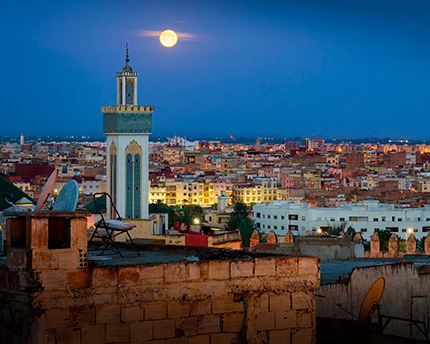Volubilis was an ancient Roman city but only remnants of its past splendour remain, despite having been inhabited up to the 18th century. It’s around 20 km from Meknes and about 60 km from Fez, at the foot of Mount Zerhun, and is one of the best-preserved Roman sites in North Africa.
The ruins of Volubilis are Morocco’s most important archaeological monument and have been made a UNESCO World Heritage Site, particularly due to the impressive mosaics. At its zenith, the Roman city was inhabited by up to 20,000 people and its most notable monuments were built in the 2nd and 3rd centuries: the triumphal arch, capitol, baths and the basilica. It was sacked in the 18th century for its marble, which was used to build palaces in Meknes.
History of Volubilis
Archaeologists have proved that the first people to settle at Volubilis (Morocco) were Carthaginian traders in 3rd century BC; the Romans later took control of the city in 40 AC, building its most impressive monuments in the 2nd and 3rd centuries.
The Romans abandoned Volubilis in around 280 AC following attacks from Berber tribes. In the 8th century, Idris I stayed here before transferring the capital of his kingdom to Fez. Volubilis was inhabited up to the 18th century.
What to see at Volubilis
You can find official guides to show you around the Roman ruins of Volubilis (Morocco) at the site itself and they take you on reasonably priced tours that last approximately an hour.
It’s a good idea to hire a guide if you’re interested in learning more about the history hidden beneath the stones of this astonishing archaeological complex because there are very few information signs.
There is plenty to see – and only 50% of the site has been excavated to date. The most important monuments are in the area furthest from the entrance.
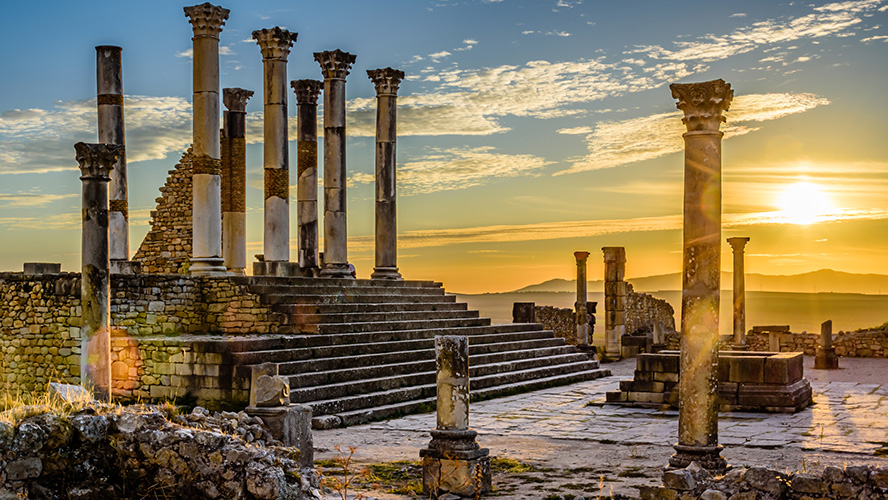
Forum, basilica and Temple of Jupiter. The ancient forum was the heart of the city’s public and social life. It contains the Temple of Jupiter, Juno and Minerva, and the basilica, some of the most important monuments in Volubilis. The basilica columns have been rebuilt and are often crowned by stork nests. You can also spot Latin inscriptions at the base of several statues.
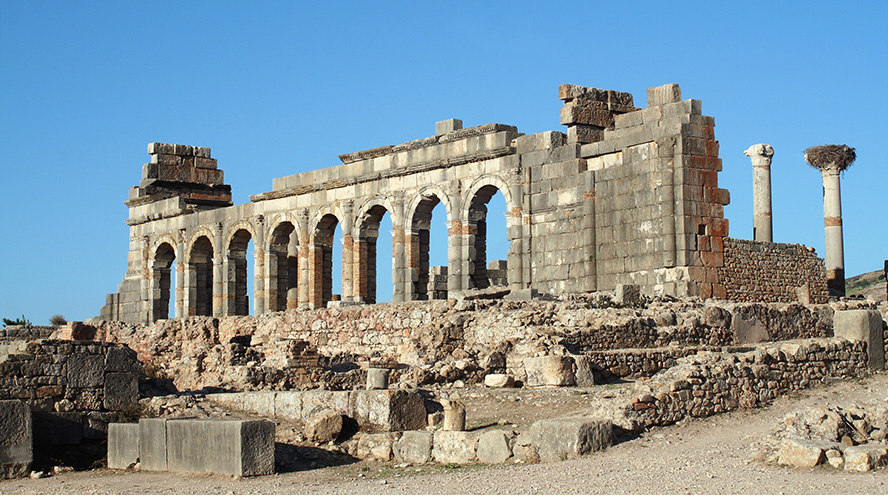
House of Orpheus. This is the largest and most beautiful house in Volubilis. You’ll spot a mosaic with the figure of Orpheus playing the lute to enchant the animals, and a mosaic of a dolphin. It has a private “hammam” with a hot room with steam tubes (caldarium), a tepid room (tepidarium), a cold room (frigidarium) and a solarium. The House of the Acrobat is to the left of the House of Orpheus; it contains a mosaic of an athlete receiving a trophy and is also well worth visiting.
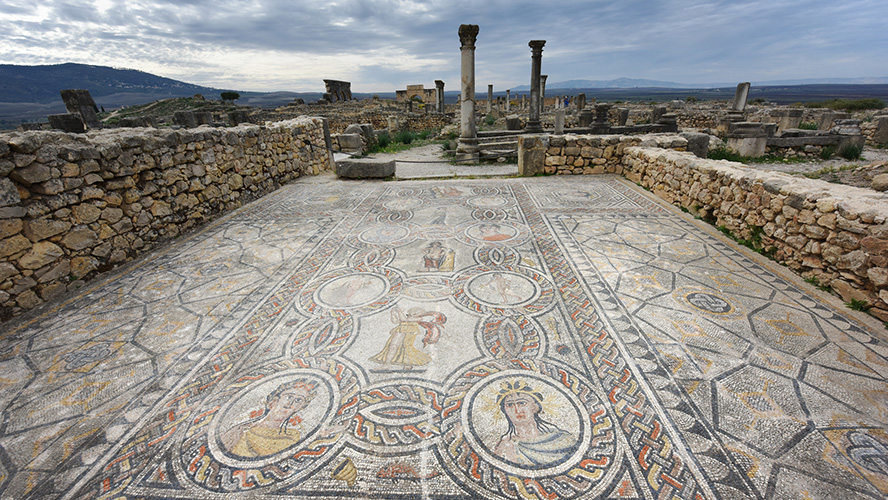
Baths. The remains of the Baths of Gallienus are next to the House of Orpheus. This Roman hammam reveals just how sophisticated underground heating systems were. The baths have a series of low arches and, next to the steam room, the remains of what were once communal toilets.
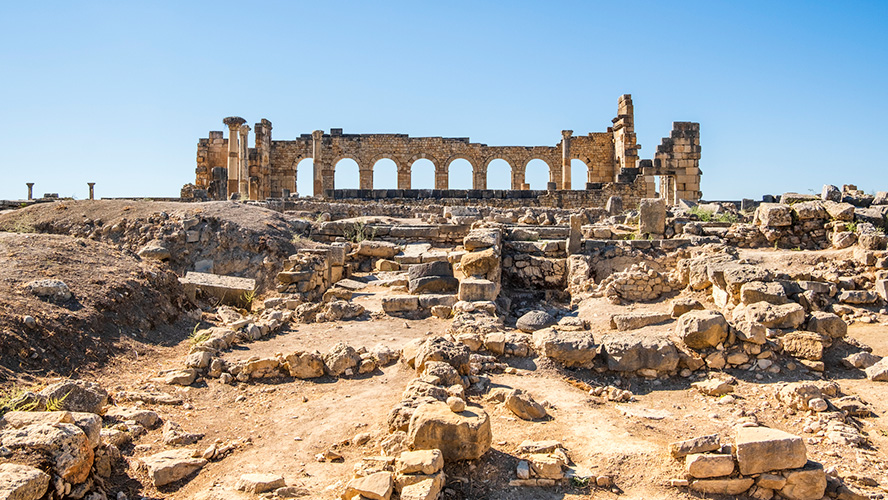
Triumphal Arch of Caracalla. The Triumphal Arch of Volubilis was built in marble in 217 AC in tribute to Emperor Caracalla and his mother, Julia Domna. The arch was once crowned by a bronze chariot with four horses that was rebuilt in the 1930s. The arch has wonderful panoramic views of the whole site.
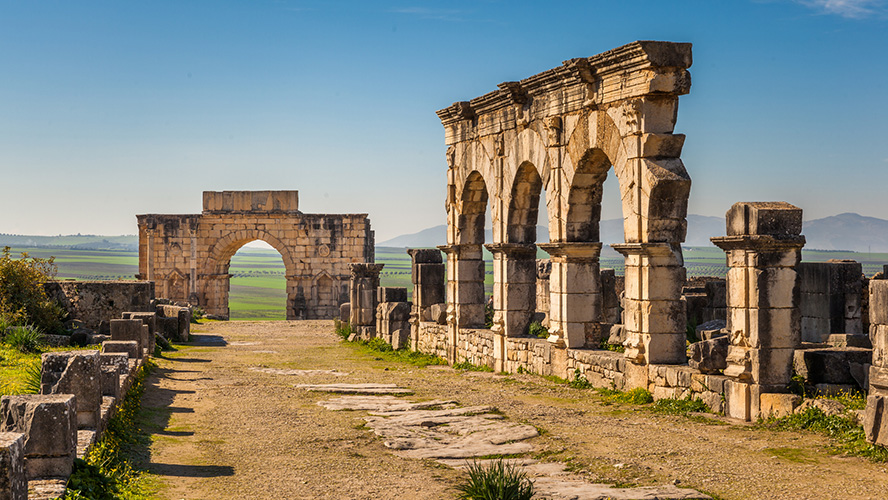
Mosaics. The mosaics of Volubilis are the most valuable feature of the archaeological complex. Almost all the houses in the site contain mosaics and many are named after the images the mosaics depict, such as the House of the Tasks of Hercules, the House of the Ephebe, the House of Dionysus and the Four Seasons, the House of the Bathing Nymphs and the House of the Wild Beasts. The finest mosaics are in the House of Venus and they portray romantic and erotic themes: “The Abduction of Hilas by the Nymphs” and “The Bath of Diana”.
What to see near Volubilis
Meknes and Volubilis are practically neighbours. The town of Moulay Idriss is also very close, and both Meknes and Moulay Idriss are destinations that you can easily combine with a visit to the archaeological site.
Meknes. Ancient seat of the Moroccan sultanate, the three fortifications of Meknes reveal how important the town once was. The tomb of Sultan Moulay Ismail lies in the centre of what remains of the original imperial city, flanked by Bab El Mansur Gate and El Hedim Square, a local version of famous Jemaa el-Fnaa in Marrakesh. The ancient medina is in this area and the easiest way to reach the souks is by passing through the arch next to Dar Jamai Museum. Once through the arch, you’ll quickly spot stands selling souvenirs, rugs and hand-crafted goods.
Moulay Idriss. Named in tribute to Idris I, Morocco’s most venerated saint, this pretty, white-washed town is home to his mausoleum and is one of the most important pilgrimage sites in the country. Moulay Idriss is just 5 km from Volubilis and the town’s skyline is notable for having the only cylindrical minaret in Morocco.
Idris I was the grandson of Mohammed and founded the first royal dynasty in Morocco.
He had to flee Mecca at the end of the 8th century following persecution by the recently established Abbasid Caliphate, which had its seat in Baghdad; Idris I moved to Volubilis, where he converted the locals to Islam and founded the Idrisid dynasty. The historic centre of Moulay Idriss is well worth visiting.
How to get to Volubilis
The easiest and fastest way to get to Volubilis is by booking return trip with a “grand taxi” from Meknes and making a short stop in Moulay Idriss. Taxis can normally be found near the French Institute of Meknes and you sometimes share with other passengers. Remember, you won’t usually find taxis in Volubilis so you should book your return journey in advance with your driver.
Useful information (price, opening times, etc.)
An entrance ticket to the Roman site of Volubilis is 70 dirhams for adults and 30 dirhams for under-12s. It opens from 8 a.m. to 7.30 p.m. in summer and 8 a.m. to 5.30 p.m. in winter. Rates for tour guides are negotiated directly with the guide. Parking is free and there is a small restaurant where you can buy something to eat and drink. In summer, make sure to wear a hat or cap because there is no shade.
Where to stay in Fez
If you’d like to visit Volubilis on your trip to Fez and stay at a hotel where rest and comfort is guaranteed, we recommend choosing the Barceló Fès Medina because it’s excellent value for money. This welcoming four-star hotel is right next to the medina, 5 minutes from the train station and 20 minutes from Fès-Saïss international airport. It has 134 modern, fully-equipped rooms and extremely comfortable spaces. The hotel has its own international restaurant where you can also enjoy typical Moroccan food, and a Jazz Bar that serves delicious cocktails. It also has a spa so you can unwind, book a treatment, and use the sauna, hammam and gym. It’s the perfect oasis where you’re sure to feel at home.




































































